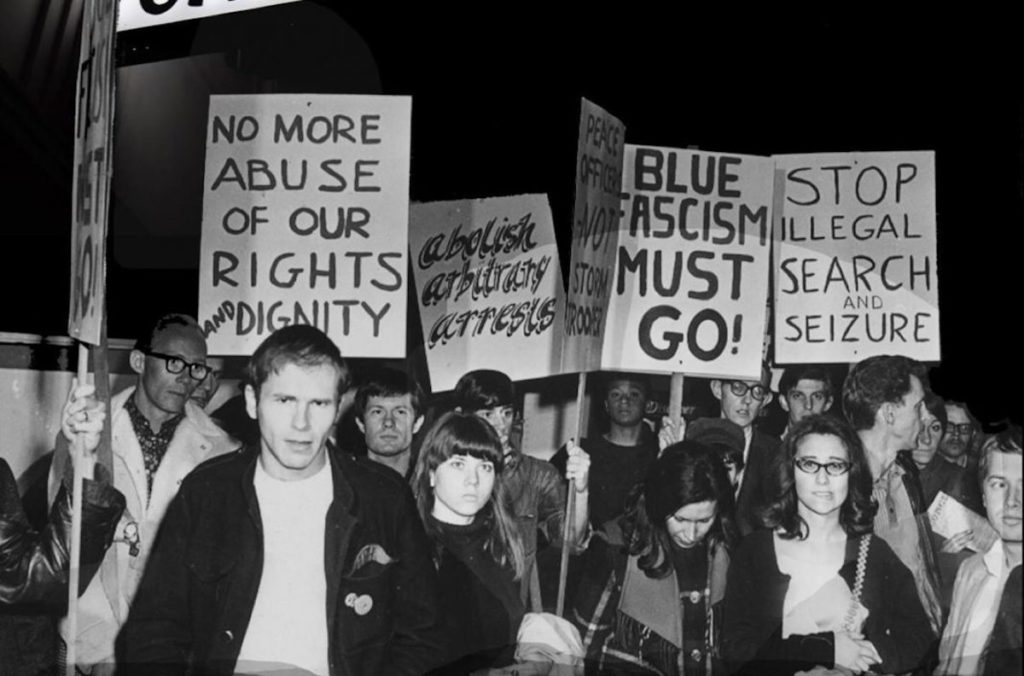Shortly after midnight on Jan. 1, 1967, as balloons dropped from the ceiling to mark the New Year at the Black Cat, undercover Los Angeles police officers, who were waiting for the right moment to pounce.
Moments later, they did, ripping holiday decorations from the wall, beat and arrested 14 people at the popular Silver Lake gay bar. Six people were booked and eventually charged with lewd conduct because they were kissing.
Six weeks later, on Feb. 11, hundreds of demonstrators picketed in front of the Black Cat and demanded the Los Angeles Police Department stop attacking and arresting gay people. Protestors carried signs that read “End Illegal Entrapment,” “Peace in Silver Lake” and “Police Lawlessness Must Be Stopped.”
While the Black Cat protest didn’t change Los Angeles police policy toward the gay community, it was one of the first public demonstrations by the gay community against police brutality. It predates the Stonewall Rebellion in New York and is one of the earliest protests for gay rights in Southern California.

Demonstrators protest outside The Black Cat bar in Silver Lake on Feb. 11, 1967, approximately six weeks after Los Angeles police officers conducted a violent raid at the venue on Jan. 31, 1966. Photo: ONE Archives at USC Libraries.
The landmark Black Cat demonstration — along with numerous others in Los Angeles, San Francisco, and across the country in the mid-1960s — helped launch the gay civil rights movement.
The Black Cat was recognized last week as the first California historical landmark that honors LGBTQ+ history.
It’s designated California Historical Landmark #1063.
“It’s an honor that we still remember what has happened because if we don’t remember, it can revert back to the way it was,” Alexei Romanoff, 87, one of the few living Black Cat demonstrators, said at the ceremony on Sunday.
Romanoff also helped organize the protest 56 years ago.
Lee Glaze led early gay rights protest at The Patch 55 years ago
Same-sex dancing, hugging, and kissing was illegal.
In previous raids and acts of terror by the Los Angeles police at gay spaces, the suspects didn’t do much resistance.
But this time, activists publicly pushed back.
The Black Cat protest was organized by people using phone trees, meaning they called 10 friends who in turn called 10 friends who called 10 more friends.
No stories of the arrests or the protest turned up in mainstream newspapers.
“The free press were the only ones that covered our demonstration,” Romanoff, in a 2015 interview with Thirsty in L.A. “None of the regular media were here. That was one of the fears we had, that if the regular media were here and took pictures, that we would lose our jobs, we would lose our homes, and we’d be alienated by our families.”
The Black Cat plaque — sponsored by the California Landmark Foundation, the Bill Beaver Project, and the California Department of Parks — is near the building, at the intersection of Hyperion Ave. and Silver Lake Blvd.
“It is important to teach an inclusive history of California because everyone deserves to have their history told,” Ray Najera, executive director of the California Landmark Foundation, said at the event. “The state landmark system has been in place almost 100 years. This is a step in the right direction.”
The Black Cat also received Historic-Cultural Monument status from the City of Los Angeles in 2008.
